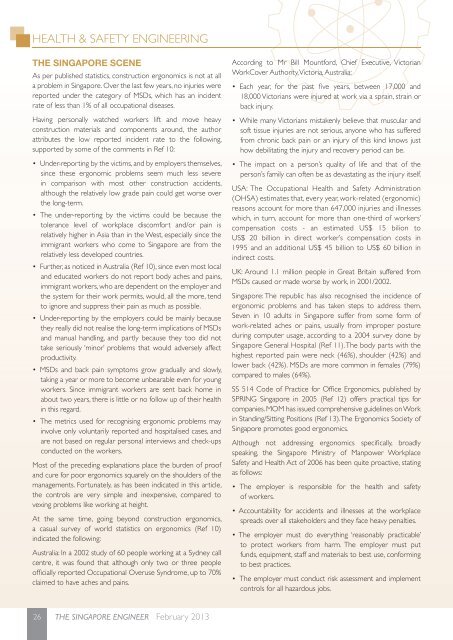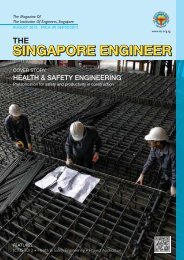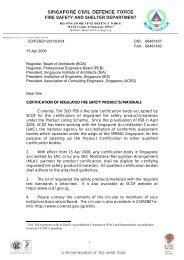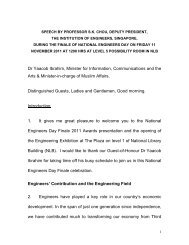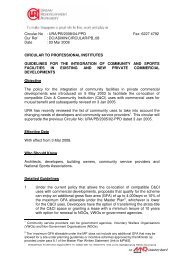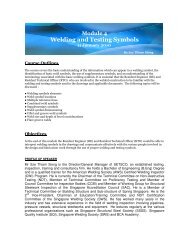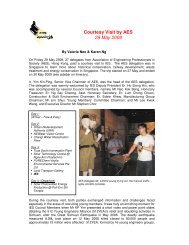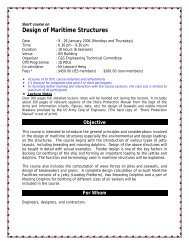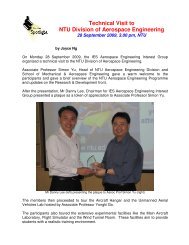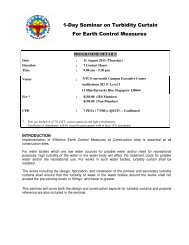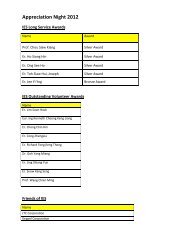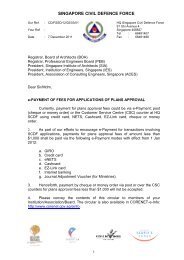civil & structural engineering - Institution of Engineers Singapore
civil & structural engineering - Institution of Engineers Singapore
civil & structural engineering - Institution of Engineers Singapore
You also want an ePaper? Increase the reach of your titles
YUMPU automatically turns print PDFs into web optimized ePapers that Google loves.
HEALTH & SAFETY ENGINEERING<br />
THE SINGAPORE SCENE<br />
As per published statistics, construction ergonomics is not at all<br />
a problem in <strong>Singapore</strong>. Over the last few years, no injuries were<br />
reported under the category <strong>of</strong> MSDs, which has an incident<br />
rate <strong>of</strong> less than 1% <strong>of</strong> all occupational diseases.<br />
Having personally watched workers lift and move heavy<br />
construction materials and components around, the author<br />
attributes the low reported incident rate to the following,<br />
supported by some <strong>of</strong> the comments in Ref 10:<br />
• Under-reporting by the victims, and by employers themselves,<br />
since these ergonomic problems seem much less severe<br />
in comparison with most other construction accidents,<br />
although the relatively low grade pain could get worse over<br />
the long-term.<br />
• The under-reporting by the victims could be because the<br />
tolerance level <strong>of</strong> workplace discomfort and/or pain is<br />
relatively higher in Asia than in the West, especially since the<br />
immigrant workers who come to <strong>Singapore</strong> are from the<br />
relatively less developed countries.<br />
• Further, as noticed in Australia (Ref 10), since even most local<br />
and educated workers do not report body aches and pains,<br />
immigrant workers, who are dependent on the employer and<br />
the system for their work permits, would, all the more, tend<br />
to ignore and suppress their pain as much as possible.<br />
• Under-reporting by the employers could be mainly because<br />
they really did not realise the long-term implications <strong>of</strong> MSDs<br />
and manual handling, and partly because they too did not<br />
take seriously ‘minor’ problems that would adversely affect<br />
productivity.<br />
• MSDs and back pain symptoms grow gradually and slowly,<br />
taking a year or more to become unbearable even for young<br />
workers. Since immigrant workers are sent back home in<br />
about two years, there is little or no follow up <strong>of</strong> their health<br />
in this regard.<br />
• The metrics used for recognising ergonomic problems may<br />
involve only voluntarily reported and hospitalised cases, and<br />
are not based on regular personal interviews and check-ups<br />
conducted on the workers.<br />
Most <strong>of</strong> the preceding explanations place the burden <strong>of</strong> pro<strong>of</strong><br />
and cure for poor ergonomics squarely on the shoulders <strong>of</strong> the<br />
managements. Fortunately, as has been indicated in this article,<br />
the controls are very simple and inexpensive, compared to<br />
vexing problems like working at height.<br />
At the same time, going beyond construction ergonomics,<br />
a casual survey <strong>of</strong> world statistics on ergonomics (Ref 10)<br />
indicated the following:<br />
Australia: In a 2002 study <strong>of</strong> 60 people working at a Sydney call<br />
centre, it was found that although only two or three people<br />
<strong>of</strong>fi cially reported Occupational Overuse Syndrome, up to 70%<br />
claimed to have aches and pains.<br />
According to Mr Bill Mountford, Chief Executive, Victorian<br />
WorkCover Authority, Victoria, Australia:<br />
• Each year, for the past fi ve years, between 17,000 and<br />
18,000 Victorians were injured at work via a sprain, strain or<br />
back injury.<br />
• While many Victorians mistakenly believe that muscular and<br />
s<strong>of</strong>t tissue injuries are not serious, anyone who has suffered<br />
from chronic back pain or an injury <strong>of</strong> this kind knows just<br />
how debilitating the injury and recovery period can be.<br />
• The impact on a person’s quality <strong>of</strong> life and that <strong>of</strong> the<br />
person’s family can <strong>of</strong>ten be as devastating as the injury itself.<br />
USA: The Occupational Health and Safety Administration<br />
(OHSA) estimates that, every year, work-related (ergonomic)<br />
reasons account for more than 647,000 injuries and illnesses<br />
which, in turn, account for more than one-third <strong>of</strong> workers’<br />
compensation costs - an estimated US$ 15 bilion to<br />
US$ 20 billion in direct worker’s compensation costs in<br />
1995 and an additional US$ 45 billion to US$ 60 billion in<br />
indirect costs.<br />
UK: Around 1.1 million people in Great Britain suffered from<br />
MSDs caused or made worse by work, in 2001/2002.<br />
<strong>Singapore</strong>: The republic has also recognised the incidence <strong>of</strong><br />
ergonomic problems and has taken steps to address them.<br />
Seven in 10 adults in <strong>Singapore</strong> suffer from some form <strong>of</strong><br />
work-related aches or pains, usually from improper posture<br />
during computer usage, according to a 2004 survey done by<br />
<strong>Singapore</strong> General Hospital (Ref 11). The body parts with the<br />
highest reported pain were neck (46%), shoulder (42%) and<br />
lower back (42%). MSDs are more common in females (79%)<br />
compared to males (64%).<br />
SS 514 Code <strong>of</strong> Practice for Offi ce Ergonomics, published by<br />
SPRING <strong>Singapore</strong> in 2005 (Ref 12) <strong>of</strong>fers practical tips for<br />
companies. MOM has issued comprehensive guidelines on Work<br />
in Standing/Sitting Positions (Ref 13). The Ergonomics Society <strong>of</strong><br />
<strong>Singapore</strong> promotes good ergonomics.<br />
Although not addressing ergonomics specifi cally, broadly<br />
speaking, the <strong>Singapore</strong> Ministry <strong>of</strong> Manpower Workplace<br />
Safety and Health Act <strong>of</strong> 2006 has been quite proactive, stating<br />
as follows:<br />
• The employer is responsible for the health and safety<br />
<strong>of</strong> workers.<br />
• Accountability for accidents and illnesses at the workplace<br />
spreads over all stakeholders and they face heavy penalties.<br />
• The employer must do everything ‘reasonably practicable’<br />
to protect workers from harm. The employer must put<br />
funds, equipment, staff and materials to best use, conforming<br />
to best practices.<br />
• The employer must conduct risk assessment and implement<br />
controls for all hazardous jobs.<br />
26 THE SINGAPORE ENGINEER February 2013


